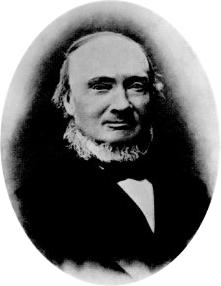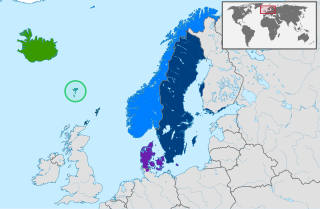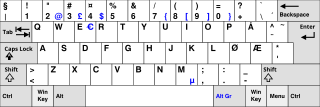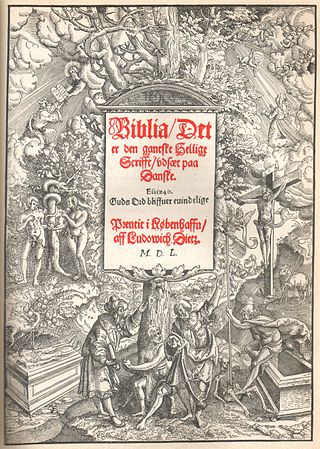
Ivar Andreas Aasen was a Norwegian philologist, lexicographer, playwright, and poet. He is best known for having assembled one of the two official written versions of the Norwegian language, Nynorsk, from various dialects.

Norwegian is a North Germanic language spoken mainly in Norway, where it is an official language. Along with Swedish and Danish, Norwegian forms a dialect continuum of more or less mutually intelligible local and regional varieties; some Norwegian and Swedish dialects, in particular, are very close. These Scandinavian languages, together with Faroese and Icelandic as well as some extinct languages, constitute the North Germanic languages. Faroese and Icelandic are not mutually intelligible with Norwegian in their spoken form because continental Scandinavian has diverged from them. While the two Germanic languages with the greatest numbers of speakers, English and German, have close similarities with Norwegian, neither is mutually intelligible with it. Norwegian is a descendant of Old Norse, the common language of the Germanic peoples living in Scandinavia during the Viking Age.

The North Germanic languages make up one of the three branches of the Germanic languages—a sub-family of the Indo-European languages—along with the West Germanic languages and the extinct East Germanic languages. The language group is also referred to as the Nordic languages, a direct translation of the most common term used among Danish, Faroese, Icelandic, Norwegian, and Swedish scholars and people.
Bokmål is an official written standard for the Norwegian language, alongside Nynorsk. Bokmål is the preferred written standard of Norwegian for 85% to 90% of the population in Norway. There is no nationwide standard or agreement on the pronunciation of Bokmål.
Nynorsk is one of the two official written standards of the Norwegian language, the other being Bokmål. From 12 May 1885, it became the state-sanctioned version of Ivar Aasen's standard Norwegian language parallel to the Dano-Norwegian written language (Riksmål). Nynorsk became the name in 1929, and it is after a series of reforms still a variation which is closer to Landsmål, whereas Bokmål is closer to Riksmål and Danish.
Riksmål is an unofficial written Norwegian language form or spelling standard, meaning the National Language, closely related and now almost identical to the dominant form of Bokmål, known as Moderat Bokmål.
The Norwegian Academy for Language and Literature, commonly known as the Norwegian Academy, is a Norwegian learned body on matters pertaining to the modern Norwegian language in its Dano-Norwegian variety, now commonly known as Riksmål and Bokmål. The academy was established in the Norwegian government's honorary residence Grotten in 1953 based on the model of the Swedish Academy and the French Academy, but the idea was originally conceived by Bjørn Bjørnson in 1913. Its members are elected for life on the basis of scholarly, literary or artistic merits. The academy publishes the main dictionary of Norwegian, Det Norske Akademis ordbok, is responsible for regulating the written standard known as Riksmål and has a literary and cultural purpose. The academy awards the Norwegian Academy Prize in memory of Thorleif Dahl.

Danish, Norwegian and Swedish are all descended from Old Norse, the common ancestor of all North Germanic languages spoken today. Thus, they are closely related, and largely mutually intelligible, particularly in their standard varieties. The largest differences are found in pronunciation and language-specific vocabulary, which may hinder mutual intelligibility to some extent in some dialects. All dialects of Danish, Norwegian and Swedish form a dialect continuum within a wider North Germanic dialect continuum.

There are two Norwegian language editions of Wikipedia: one for articles written in Bokmål or Riksmål, and one for articles written in Nynorsk or Høgnorsk. There are currently 613,863 articles on the Norwegian Wikipedia edition in Bokmål/Riksmål, and 166,230 articles on the Nynorsk edition.

Elias Blix was a Norwegian professor, theologian, hymn writer, and a politician for the Liberal Party. Blix wrote numerous hymns and was largely responsible for translating the New Testament into the Norwegian language.

The Norwegian language conflict is an ongoing controversy in Norwegian culture and politics related to the written versions of Norwegian. From 1536/1537 until 1814, Danish was the standard written language of Norway due to the union of crowns with Denmark, in which time the Danish Empire was founded. As a result, the overall form of chosen modern written Norwegian and its leaning towards or away from Danish underpins controversies in anti-imperialistic nationalism, rural versus urban cultures, literary history, diglossia, spelling reform, and orthography.

Carl Paul Caspari was a Norwegian neo-Lutheran theologian and academic. He was a Professor of Old Testament Theology at the University of Oslo. He wrote several books and is best known for his interpretations and translation of the Old Testament.

Many languages are spoken, written and signed in Norway.
Det Norske Samlaget is a Norwegian publishing house founded on 24 March 1868 with the aim to promote and publish books in Landsmål, now known as Nynorsk.
Bible translations into Danish prior to the Danish Reformation were limited. However in the mid-16th century with the Reformation's emphasis on direct study of the Bible, the need for Danish-language editions accelerated. Currently, the Danish Bible Society oversees translation and production of Church of Denmark-authorized Danish-language Bibles with the most recent full translation completed in 1992.

Bible translations in Norway date back to the late 13th century. Since the first spread of Christianity in Norway, numerous translations of the Bible have been published. Translations have appeared in several of the official languages that Norway has had throughout its history, including editions in Old Norse, Danish, and both current standard forms Nynorsk and Bokmål.
Språkåret in Norway was arranged with government support in 2013. That year was 200 years after Ivar Aasen was born. It was 100 years after Det Norske Teatret opened. Ivar Aasen's life work was the development of Nynorsk, a language with grammar and vocabulary based upon the way ordinary Norwegians, primarily rural, spoke. After a few hundred years under Danish rule, many in the cities as well as everyone educated in Denmark, spoke and wrote Danish and Danish was taught in schools. Det Norske Teatret is a theatre in Oslo that primarily produces plays in Nynorsk.
Norsk Salmebok, published in 1985, was the official hymnal of the Church of Norway from 1985 to 2013.
Nynorsk salmebok is a Nynorsk hymnal that was edited by Bernt Støylen, Peter Hognestad, and Anders Hovden, and first published in 1925. Under a royal resolution of December 18 that year, it was recognized for use in worship services and in country church parishes that adopted it. The hymnal originally contained 711 hymns, and under the royal resolution of October 1, 1926 it was decided to supplement it with 200 Bokmål additions from the old and new Landstad hymnal.
The Swedish Bible Society is a Swedish Christian non-profit organization founded on 22 February 1815 to spread the Bible to the Swedish people. It was inspired by the British and Foreign Bible Society, which had been founded in 1804. Today, its work is focused on promoting and facilitating Bible reading and use. Bible societies were gradually established in all dioceses in Sweden, but over time the activities have taken different forms. Internationally, the Bible Society has been part of the United Bible Societies (UBS) since 1946.











